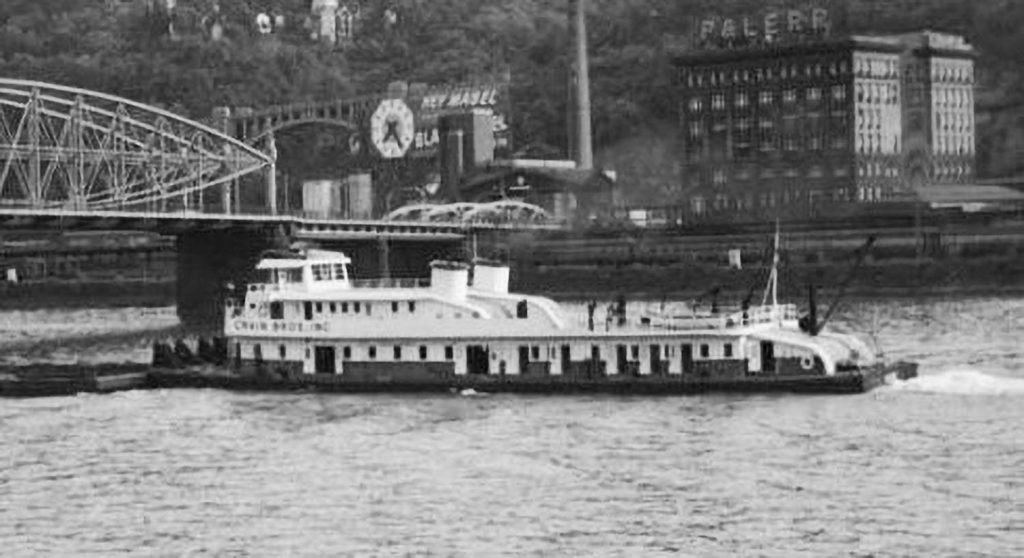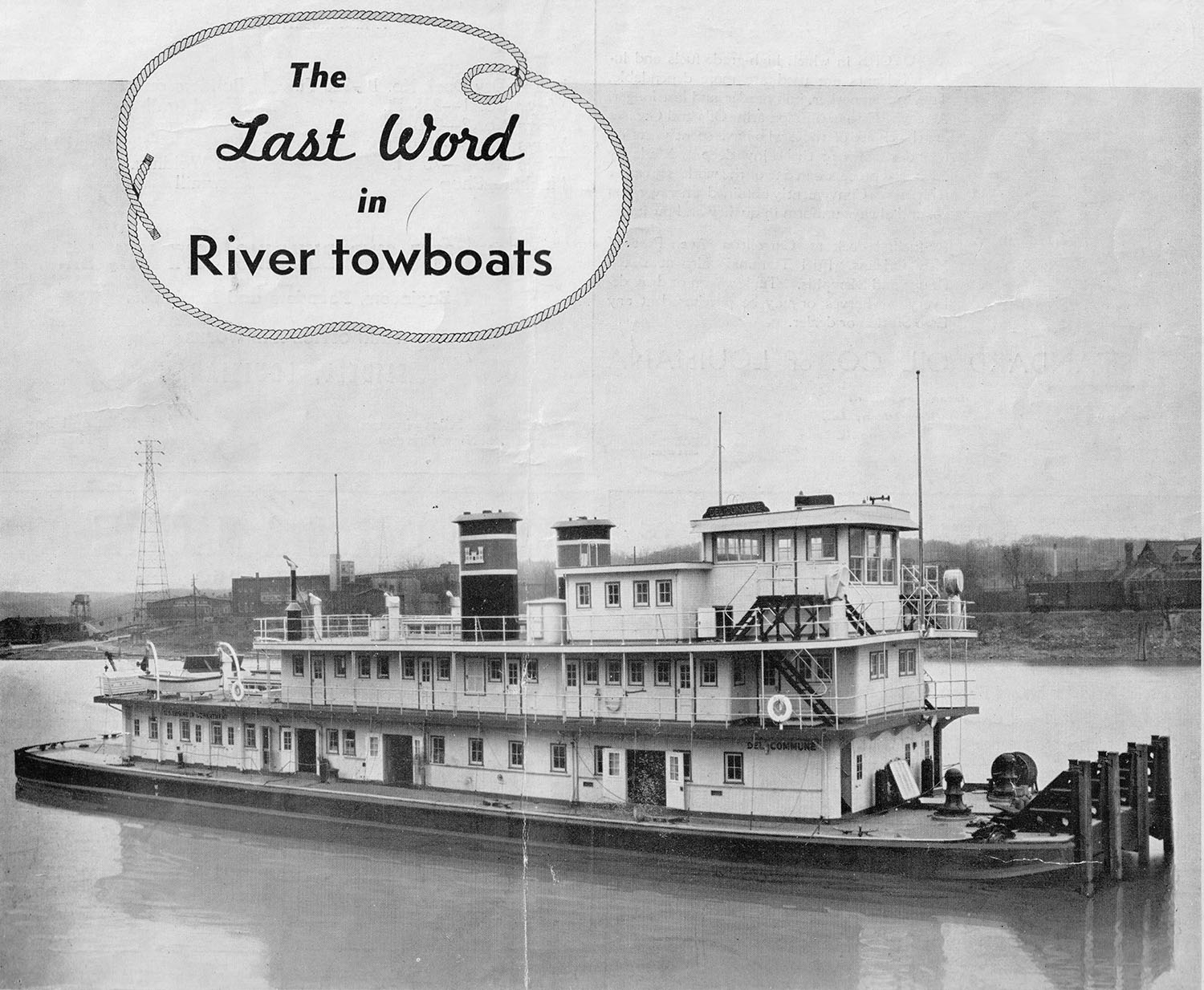Dubuque Boat & Boiler Company, Dubuque, Iowa, had a history dating back to 1852 as Rouse, Dean & Company, a foundry and machine shop. A few years later the firm was renamed Iowa Iron Works, and built stationary engines, steamboat castings and columns for buildings. According to Encyclopedia Dubuque, the keel of the first iron hull built at Dubuque—for the sidewheel steamer Clyde—was laid in 1870. In 1902, the company would build the famous steam sternwheel towboat Sprague, which would be the largest of its type ever constructed. In 1904, the company was reorganized into the Dubuque Boat & Boiler Company.
Dubuque had a longstanding relationship with the U.S. Engineer Department, dating back to the Iowa Iron Works and the snagboat James B. McPherson built there in 1891. Through the years many other vessels would be constructed by Dubuque for the Engineers, such as the Lieut. Augustin (WJ June 26, 2023) and the W.M. Rees (WJ May 1, 2023). It was no surprise when an announcement was made in early 1937 that Dubuque was again building a towboat for the Engineer Department.
In the Personal Comment column of the August 14, 1937, issue of The Waterways Journal were portions of a letter from C.E. Schrodes, chief engineer of the U.S. sidewheel light tender Willow. He informed the readers that “I have been assigned by the Bureau of Lighthouses as superintendent of construction on the new tender Goldenrod now under construction at the shipyards of the Dubuque Boat & Boiler works.” He went on to say that “This yard is a very busy place at present. The new Del Commune, building for the U.S. Engineers, is about ready to launch.”
The location of the shipyard in the Dubuque harbor was prone to silting, and prior to the launch of the new Del Commune the harbor area had to be dredged to have enough depth to float the large vessel. A story in the October 30, 1937, WJ detailing news of floating equipment being built mentioned that low water had delayed the launching of the new boat for the Engineer Department until October 23. The piece noted that the cost of the Del Commune was $262,000 ($5.5 million today) and that it was expected that it would replace the steam sternwheel Tuscumbia (Ways T2476).
The Del Commune had a steel hull that measured 160 by 36 feet and had a depth of 8 feet. Photos of the boat taken during construction show that the hull and lower cabin were of riveted steel construction, and the upper works were crafted out of wood. There was a second cabin that stretched about three-quarters of the length of the main cabin, and there was a shorter cabin behind the elevated pilothouse. Two large smokestacks were behind the short cabin, and their tops extended above the pilothouse’s roof.
According to NavSource, which details vessels of the Army and Navy, the Del Commune was named in honor of Charles L. Del Commune, a native of Ste. Genevieve, Mo., and a civil engineer with the U.S. Engineers, St. Louis District, for 44 years. According to other sources, he was affectionately referred to as “Charlie Dell” by those who worked with him on river improvement work within the department. The 1950 edition of the Inland River Record noted that he passed away on March 28, 1936.
While most of the boats built for the Engineer Department by Dubuque had been steam-powered, they had built the small 250 hp. diesel survey boat Sergeant Pryor (WJ October16, 2023) in 1935. The Del Commune was also diesel-powered, having a pair of Fairbanks-Morse model 37, 6 -cylinder, two-cycle solid injection engines with 14-inch bore and 17-inch stroke rated at a total of 1,030 hp. at 250 rpm.
The Del Commune did go in service for the U.S. Engineers St. Louis office, and did replace the Tuscumbia, which was sold at auction to Minneapolis Dredging on October 29, 1937. The new Del Commune was frequently featured in ads for Fairbanks-Morse on the front covers of the WJ in 1938. One such ad, in the March 19, 1938, issue, declared that it was “The Last Word in River Towboats.” About 1949, the Del Commune was transferred to the Louisville District of what was by then the Corps of Engineers.

In 1955 the boat was sold at a public sale to Crain Bros. Inc., Pittsburgh, and renamed Allegheny, the first diesel boat of that name following several steam vessels. Crain Bros. remodeled and streamlined the superstructure of the boat, and photos indicate that this work may have been done over time. The wooden upper cabins and pilothouse were replaced with steel structures, and the original stacks appear to have been utilized but lowered and canted back. Despite the modernization of the cabins, the IRR does not indicate that the boat was ever repowered. Crain Bros. often featured a photo of the Allegheny in ads in the WJ.
Photos dated January 19, 1968, depict the boat following a bad fire. In the December 21, 1968, Annual Review issue of the WJ, the Allegheny is listed in a table as having been dismantled, but shows the owner as being Matthew Philips.
Caption for top photo: Fairbanks-Morse ad on the cover of the March 19, 1938, WJ. (David Smith collection)
Capt. David Smith can be contacted at davidsmith1955obc@gmail.com.




